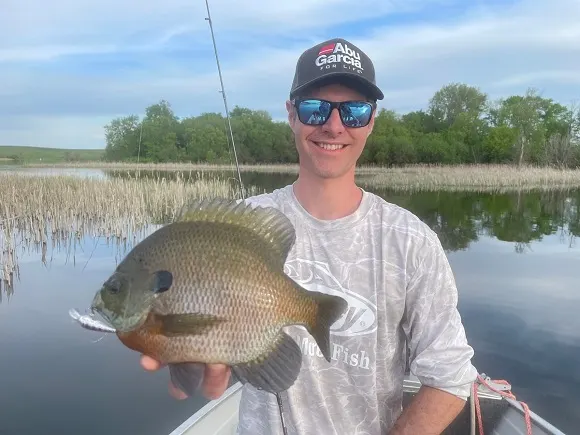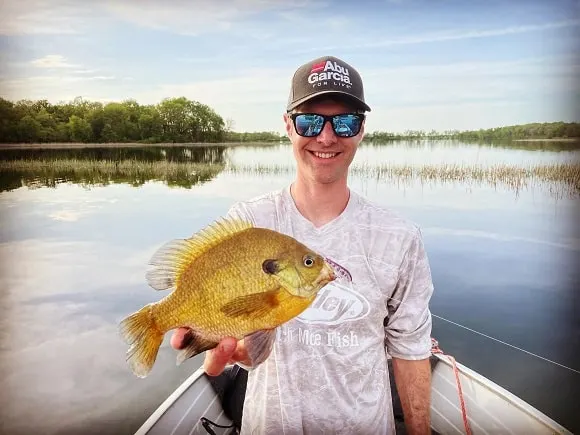The bluegill is one of America’s most popular game fish. You can locate and catch it reasonably easily, and it makes for some excellent table fare.
However, many anglers shy away from trying to fish for them in muddy or stained water. But is it really that difficult to catch gills in such conditions?
Muddy water bluegill can be found in or near structure and heavy cover in shallow and deeper water. They can be caught on both live and artificial baits and react well to colors like white, chartreuse, and black.
Read on and get helpful tips and tricks on how to catch more bluegills in muddy water!
Where to Find Bluegill in Muddy Water?
Don’t get discouraged when fishing for bluegill in muddy water! It might appear challenging, and gills are known to be sight feeders, but catching them in stained water can be easier than you think.
True, you won’t be able to sight fish, but the thing is, you really don’t have to, as you’ll find the fish in the exact same places as in clear water.
In spring, during the spawning season, they can be found in shallow water of about 1 to 6 feet, often near heavy cover and vegetation.
After the spawn, during the summer and fall, they prefer somewhat deeper and cooler water and can be found in or near weed beds, brush piles, sunken timber, and other types of underwater structure and vegetation.
In other words, the muddy water gills’ hideouts are the same, and even though they can’t see much in such conditions, they still need to feed.
It’s the fishing technique, baits, and colors you choose that’ll make all the difference!
Best Baits for Bluegill in Muddy Water

So now that you were to find the fish in muddy water conditions, how should you go about catching them?
Both artificial and natural baits can and do work very well in stained water.
Personally, I prefer using live natural baits. Here’s why:
- They move and naturally give off vibrations that the fish can pick up easily, even in low-vis conditions.
- They have an often strong scent.
- They are of relatively small size, which the bluegills seem to prefer in stained water.
As you can see, using live baits in muddy water conditions makes a lot of sense, as they move and smell a lot.
Additionally, their small size makes them very attractive prey in stained water.
I think they want to play it safe and only go for small, easy bites when visibility is low, as the bluegill are easy targets for bigger predators as well.
Some of the best live baits for muddy water bluegills include:
- wax worms
- crickets
- worms
- maggots
When it comes to artificial baits, try to go for lures that vibrate and make a lot of noise. As the fish won’t be able to see very much, you’ll have to get their attention via movement and vibrations!
Fitting lure choices for stained water gills would hence include the following:
- crankbaits
- inline spinners
- spinnerbaits
Basically, you’ll want to use anything that rotates, rattles, or wobbles!
Lure colors also play a major role in muddy water conditions, so let’s go through that section next!
Best Colors for Bluegill in Muddy Water

Whenever I cover an article topic like this, I’ll run massive online polls in fishing groups and forums to find out what works best for other anglers out there.
It is a very reliable and valuable source; if it works for others, it’ll work for you, too, right?
You might think that the choice of color for your lure isn’t all that important in low-vis conditions, but it’s actually one of the most vital things to consider!
If you’re using the wrong color, you might end up going home empty-handed, especially when fishing in stained water.
It’s such an important aspect of fishing and one that is often overlooked, especially by beginners.
I ran this poll in several huge bluegill fishing FB groups and got a few hundred votes, making the result very reliable.
So what Is the best lure color for bluegill in muddy water?
| White | 40% |
| Chartreuse | 40% |
| Black | 20% |
White and chartreuse are self-evident choices if you ask me. They are bright and flashy, stick out quickly in the stained water, and can hence be located very easily.
PRO TIP: Colors like yellow, orange, and pink also got a few votes and are definitely worth trying out if the fishing is slow.
But what about black? That’s a pretty odd choice for stained water conditions, right? Well, yes and no!
Black can actually work surprisingly well in dark and muddy water! That’s because very dark colors, like black, have a super strong silhouette.
It might go against your logic, but black lures represent a solid shape underwater, even if stained, in low-light and low-vis conditions.
Due to that solid shape, they just stick out a lot, making them a secret weapon when fishing in muddy water!
Is Fishing for Bluegill Better in Clear or Stained Water?

This is a difficult question, as both conditions have advantages and disadvantages for us anglers. Personally, I’d always prefer fishing in stained over clear water.
However, I would only like the water to be mildly stained. Often, though, that’s just wishful thinking. Conditions are barely ever optimal, and they can change fast. The best thing we, as anglers, can do is to adapt and experiment.
Furthermore, this isn’t to say that clear water bluegills must be challenging to catch.
On the contrary, seeing the fish can often make things much easier, as you can easily and quickly locate and target them.
You can also study their reaction and behavior, allowing you to adjust your techniques and baits if needed.
So, again, it really depends on many factors and you as the individual angler and your set of skills.
Both clear and muddy water can work fantastic for gills, but they can also spell disaster.
That’s fishing, my friends!
RELATED READING: How to Catch More Bluegill in Clear Water Conditions?
Can Bluegill See in Muddy Water?
There needs to be more research on this topic, and all we can do is make educated guesses.
From what I’ve read and heard from other anglers, depending on the level of visibility, the fish can still make out specific shapes, colors, and movements, even though their vision will be reduced significantly.
This would explain why they’d hit aggressive and very bright colors so much.
In extremely stained and dark water, though, they probably won’t be able to see much at all, which is when movement, vibration, and sound kick in instead.
Even though they rely heavily on sight, they do have a lateral line, as well as a pair of inner ears, helping them to detect vibration and sound underwater.
Related Articles
- What Time of Year Do Bluegill Spawn?
- What Is the Average Size of Bluegill?
- How to Catch Crappie in Muddy Water?
Featured image courtesy of Dan Spengler

